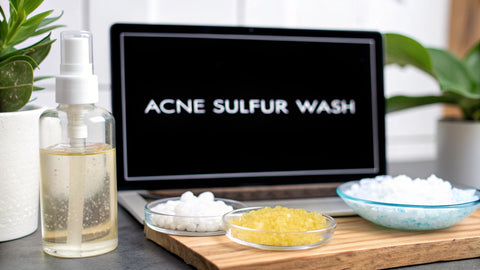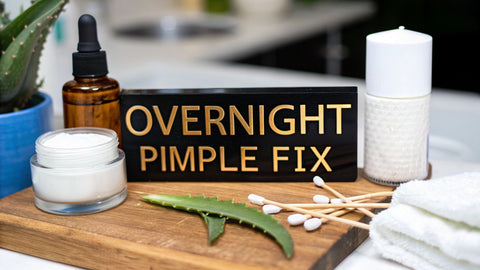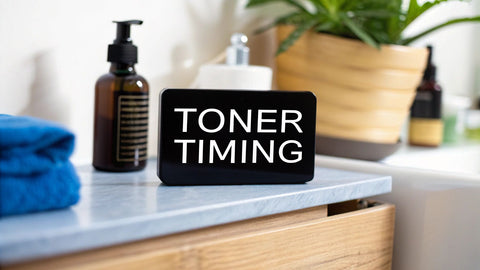Top Alternatives to Accutane for Clear Skin

Let's be honest, Accutane (isotretinoin) is a powerhouse when it comes to fighting severe, stubborn acne. For people who have tried everything else without success, it can be a game-changer. It tackles acne from the inside out by dramatically cutting down your skin's oil production, which helps stop pores from clogging and soothes inflammation.
But that power comes at a cost. Taking Accutane is a serious decision, and it’s not one that doctors or patients take lightly. This is why so many people are actively looking for effective alternatives to Accutane.
Why Look for an Accutane Alternative?
The main reason people hesitate is the long list of potential side effects. These aren't just minor inconveniences; they can range from intensely dry skin, chapped lips, and dry eyes to more significant health issues that affect your whole body.
Because Accutane is a systemic drug (meaning it works throughout your body, not just on your skin), it comes with some strict requirements.
The Trade-Offs of a Powerful Drug
Taking this medication involves a serious commitment to medical supervision. You can't just pick up a prescription and be on your way. The process typically includes:
- Regular Blood Tests: Your doctor will need to keep a close eye on your liver function and cholesterol levels, as the drug can affect them.
- Strict Pregnancy Prevention: Accutane causes severe birth defects, so female patients must follow the very strict iPLEDGE program, which involves multiple negative pregnancy tests and a commitment to using two forms of birth control.
- Mental Health Monitoring: While the science is still being debated, there have been reports linking isotretinoin to mood changes, including depression.
These demanding protocols and potential health risks are enough to make anyone pause and wonder if the results are worth it. While isotretinoin is still a go-to for severe, nodular acne that just won't quit, it's almost never the first option a doctor will suggest. In fact, while the global isotretinoin market is projected to hit USD 2.25 billion by 2033, the demand for safer treatments is growing right alongside it. You can read more about the isotretinoin drug market trends on verifiedmarketresearch.com.
The Neutralyze Approach: A Smarter First Step
This is exactly where a thoughtfully formulated, science-backed topical system comes in. A product like Neutralyze acts as a powerful first line of defense, designed to give you impressive results without exposing your body to systemic risks.
By tackling acne right at the source with clinically proven ingredients, an advanced topical regimen can often clear your skin effectively, making high-risk oral medications completely unnecessary.
Our expertise at Neutralyze is rooted in understanding how key ingredients work in harmony. Our system is built on a synergistic combination of Mandelic Acid and Salicylic Acid, supercharged by our advanced Nitrogen Boost Skincare Technology. This multi-faceted approach doesn't just clear up the pimples you have now—it helps prevent future breakouts and calms down that angry, red inflammation. It’s a complete solution that, for many, stands out as one of the best alternatives to Accutane.
A Detailed Comparison of Topical Treatments
When you're looking for an effective alternative to Accutane, topical treatments are almost always the first place you'll start. Applied right on the skin, these products go to work at the source of the problem, tackling acne directly without the full-body risks that can come with oral medications. The options are vast, with a handful of powerhouse ingredients leading the charge.
Getting to know these key players is the first step toward building a routine that actually works for you. Let's break down some of the most trusted and effective topical ingredients out there.
The Power of Retinoids
Topical retinoids are the undisputed heavyweights of acne treatment. As derivatives of Vitamin A, they're often what dermatologists recommend first. Their main job is to speed up skin cell turnover, which is just a technical way of saying they keep dead skin cells from piling up, clogging pores, and forming those pesky blackheads and whiteheads. The two you'll hear about most are Tretinoin and Adapalene.
- Tretinoin: This is a prescription-only workhorse. It’s incredibly effective against both inflamed pimples and stubborn clogged pores. But that power comes at a cost—it’s notorious for causing significant dryness, peeling, and redness, so you have to ease into it very carefully.
- Adapalene: A bit gentler than its cousin Tretinoin, Adapalene is available over-the-counter and by prescription. It’s a fantastic starting point for many people because it targets acne with less irritation. It can still cause some dryness, though. If you want to dive deeper, you can explore the benefits of Adapalene.
It’s no surprise that topical treatments dominate the acne care world. They make up roughly 47.5% of a global market valued at USD 9.22 billion. That number shows just how much trust both consumers and doctors place in these solutions as a primary alternative to Accutane.
Other Key Topical Ingredients
Retinoids aren't the only game in town. Several other ingredients are staples in the fight against acne, each bringing something different to the table. This is great because it means there are options for different skin types and acne severities.
Benzoyl Peroxide is a classic for a reason. It’s a powerful antibacterial agent that directly kills the C. acnes bacteria that causes red, angry pimples. It also helps break down dead skin cells. The downside? It can be very drying, cause redness, and has a knack for bleaching towels and pillowcases.
Azelaic Acid is a gentler option that helps unclog pores, calm inflammation, and fade the dark spots acne leaves behind. Because it’s so well-tolerated, it’s a solid choice for people with sensitive skin or rosacea. For more severe or stubborn breakouts, however, it might not pack enough of a punch on its own.
This infographic gives a great visual breakdown of how different treatments stack up when you consider their side effects, cost, and how quickly you can expect to see results.
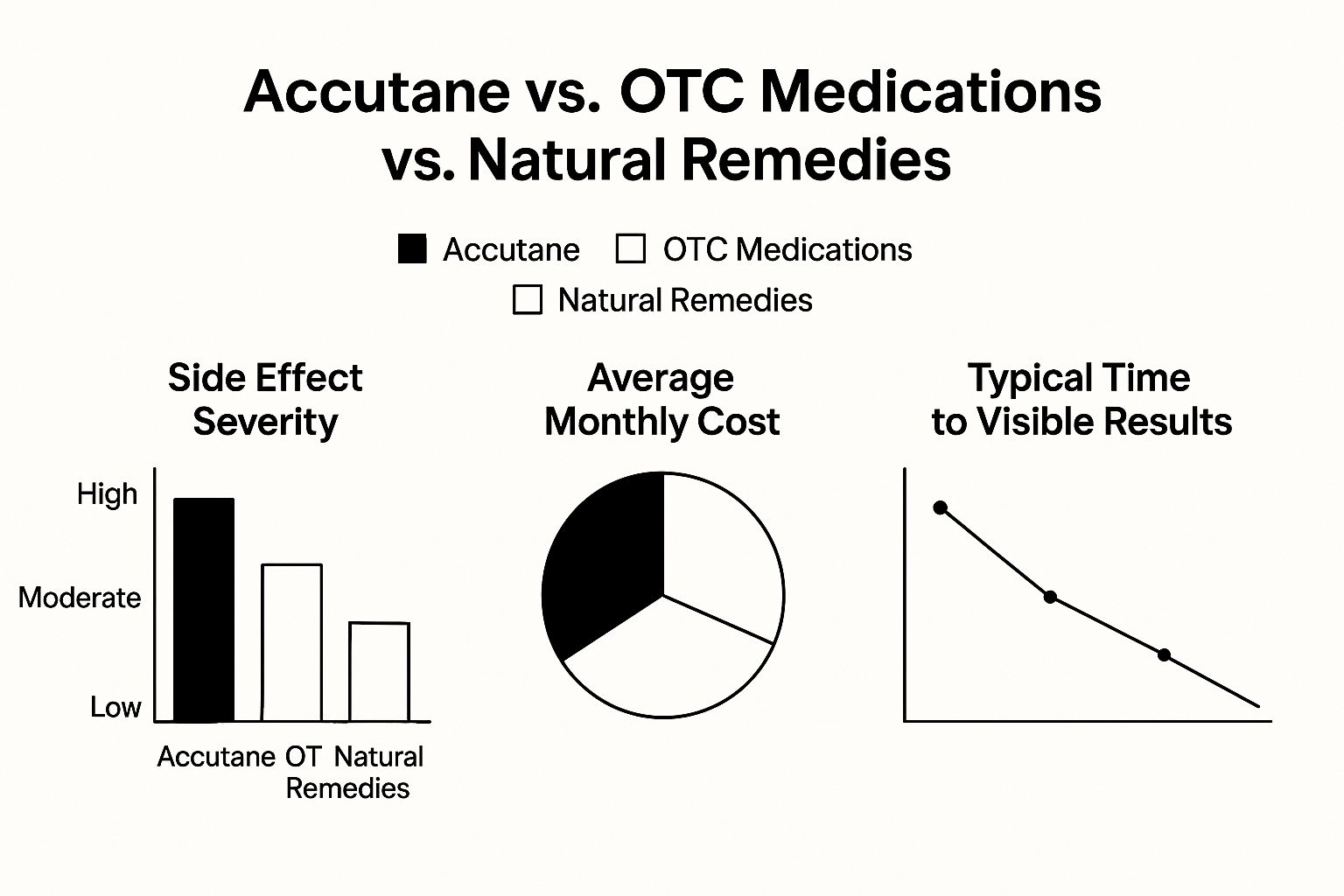
As you can see, while a powerful drug like Accutane might clear skin faster, it comes with a high risk of severe side effects. Over-the-counter topicals offer a much safer journey to clear skin.
The Neutralyze Advantage: A Multi-Ingredient System
Here’s the thing about most topical treatments: they usually rely on a single active ingredient. This often forces you into a frustrating trade-off. You can get something potent that leaves your skin red and flaky, or you can get a gentle formula that barely makes a dent in your breakouts. This is where a multi-ingredient system like Neutralyze changes the game completely.
By combining multiple, clinically proven ingredients that work together, Neutralyze tackles the complex causes of acne from several angles at once. This multi-action approach delivers powerful results without the harsh irritation often seen with single-ingredient prescription topicals.
Our formulation philosophy is built on the scientific synergy of two powerful exfoliants:
- Salicylic Acid: As a Beta Hydroxy Acid (BHA), this is the undisputed pore-clearing expert. Its oil-soluble nature allows it to penetrate deep inside pores to dissolve the mixture of sebum, dead skin cells, and debris that leads to blockages. It excels at clearing existing blackheads and preventing new ones from forming.
- Mandelic Acid: This Alpha Hydroxy Acid (AHA) has a larger molecular structure, which means it works more gently on the skin's surface. It expertly exfoliates dead skin cells, which helps fade stubborn post-acne marks, while its natural anti-inflammatory properties calm redness and irritation. It delivers powerful results with a gentleness that makes it suitable for a wide range of skin types.
If you're curious about how different acids work, this guide comparing Glycolic Acid versus Salicylic Acid offers some great insights. The synergy of a BHA and an AHA in Neutralyze means you're treating acne from both inside the pore and on the surface. It’s a comprehensive approach that a single ingredient just can't replicate, making it one of the very best alternatives to Accutane.
To make things even clearer, let's look at how these common topicals stack up side-by-side.
Comparing Leading Topical Acne Treatments
| Treatment | Key Ingredient(s) | Best For | Potential Side Effects | The Neutralyze Advantage |
|---|---|---|---|---|
| Retinoids | Tretinoin, Adapalene | Clogged pores (comedones), fine lines, and texture | Dryness, peeling, redness, sun sensitivity | |
| Benzoyl Peroxide | Benzoyl Peroxide | Inflammatory acne (pustules, papules) | Dryness, irritation, fabric bleaching | |
| Azelaic Acid | Azelaic Acid | Sensitive skin, rosacea, post-acne marks | Mild stinging or burning | |
| Neutralyze | Salicylic Acid & Mandelic Acid | All types of acne, including blackheads, whiteheads, and inflamed pimples; also targets post-acne marks | Minimal to no irritation due to the balanced formula | Synergistic Action: Combines a BHA and AHA to treat acne deep within pores and on the surface simultaneously, offering comprehensive results without harsh side effects. |
This table shows that while individual ingredients are effective for specific issues, a multi-action system like Neutralyze offers a more holistic solution. By addressing multiple acne pathways at once, you get powerful clearing action without compromising your skin's health.
Evaluating Oral Medication Alternatives
When stubborn acne just won't quit, dermatologists often look to oral medications as the next line of defense, long before the conversation turns to Accutane. These are systemic treatments, meaning they work from the inside out. They generally fall into two buckets: oral antibiotics and hormonal therapies. While they can be a game-changer for many, it's really important to understand how they work, what they can't do, and the potential risks involved.
Typically, these pills are reserved for moderate to severe acne that's either widespread or features deep, painful cysts. The goal is simple: either knock down the acne-causing bacteria or get the hormones driving excess oil production back in line.
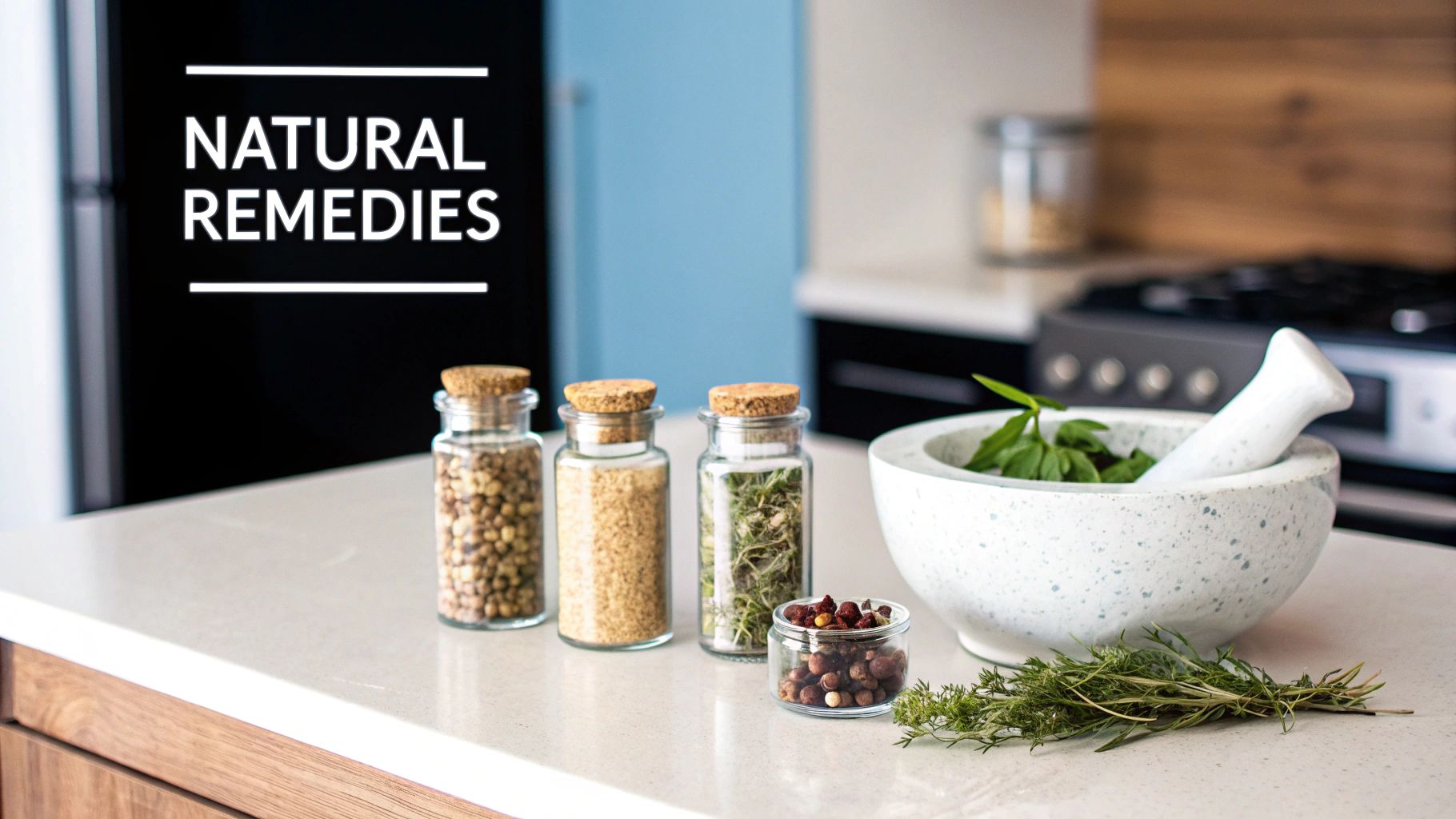
Oral Antibiotics for Inflammatory Acne
For decades, oral antibiotics like Doxycycline and Minocycline have been the standard playbook for treating inflammatory acne—we're talking about those red, angry pimples and cysts. Their main job is to reduce the population of C. acnes bacteria living on the skin, which helps calm down all that inflammation. If you're dealing with angry breakouts all over your face, chest, or back, these can bring some serious relief.
But there's a huge catch: antibiotic resistance. Overusing antibiotics can teach bacteria to outsmart the medication, which is a massive public health concern. It's a real problem.
Plus, because these drugs go through your whole system, they can mess with the good bacteria in your gut, leading to digestive upset. They're also designed for short-term use—usually just a few months—so they aren't a sustainable, long-term fix for a chronic condition like acne.
Hormonal Therapies for Adult Acne
For a lot of women, acne is directly tied to the monthly ebb and flow of hormones. A group of hormones called androgens (which women have in small amounts) can kick oil glands into overdrive, setting the stage for clogged pores. Hormonal therapies go right to the source of this problem.
-
Spironolactone: This medication works by blocking androgen receptors right at the oil gland. Think of it as telling the glands to just chill out. It's especially effective for women who get those stubborn, deep pimples along the jawline and chin, particularly ones that flare up like clockwork with their menstrual cycle.
-
Birth Control Pills: Certain combination birth control pills are actually FDA-approved to treat acne. They work by leveling out your hormones, which lowers the amount of androgens floating around and, in turn, dials back oil production.
These hormonal options can be fantastic, but they're only suitable for women and they come with their own list of potential side effects, like mood changes, headaches, and a higher risk of blood clots. You'll definitely need a prescription and close monitoring from your doctor.
The real challenge with any oral medication is that it’s systemic. It impacts your entire body just to treat a problem on your skin. That inherently raises the risk of side effects compared to a targeted topical approach.
The Advantage of a High-Performance Topical System
This is exactly where the power of a smart, multi-action topical system like Neutralyze really shines. Instead of putting a medication through your entire body, Neutralyze delivers its proven ingredients directly to the source of the breakout. We've expertly combined Salicylic Acid, which gets deep into pores to clear them out, with Mandelic Acid to gently exfoliate the surface and soothe inflammation, providing a comprehensive treatment plan in one system.
This targeted, "outside-in" approach has major advantages over oral drugs:
- Minimized Systemic Risk: You sidestep worries about antibiotic resistance or hormonal side effects completely.
- Direct Action: The ingredients get right to work on your skin, no detour through your digestive system required.
- Long-Term Management: A good topical routine is a safe, sustainable way to keep acne under control for good.
By tackling acne effectively from the skin's surface, a high-performance topical system can often reduce—or even eliminate—the need to go on systemic oral medications. It offers a much safer, but just as powerful, route to getting and keeping clear, healthy skin.
Exploring Natural and Lifestyle-Based Strategies
When you're looking for an alternative to something as serious as Accutane, it’s completely natural to start with, well… nature. The idea of clearing up your skin by changing what you eat or using plant-based remedies is incredibly appealing, and for good reason. There's a definite link between your overall health and how your skin behaves.
These holistic strategies can be fantastic for managing milder acne or even as a solid support system for a more targeted treatment plan. The key, though, is to be realistic. While they absolutely have their place, they often don't pack the clinical punch needed to get moderate to severe acne under control all on their own.
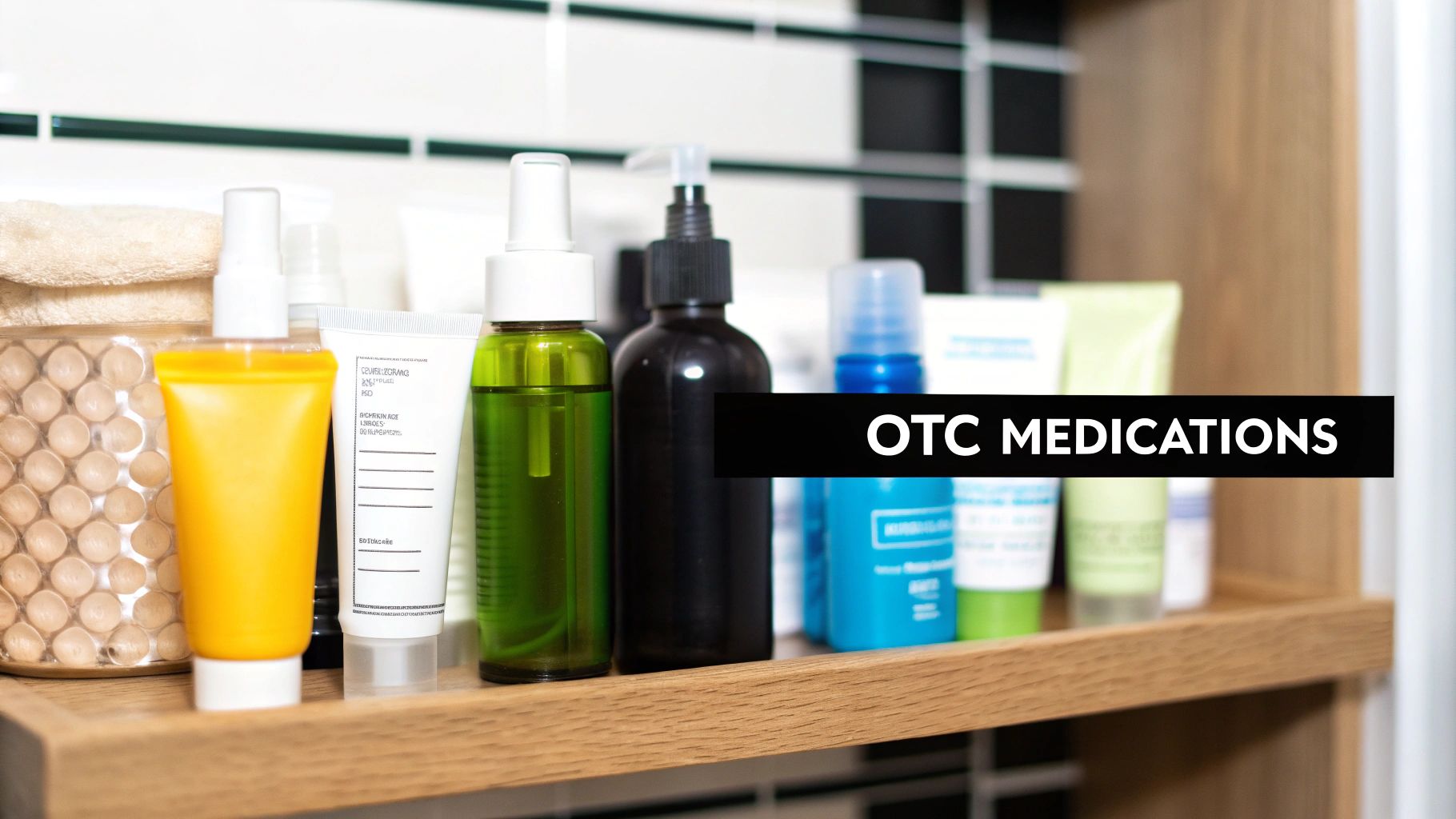
The Diet and Acne Connection
Diet is probably the biggest topic of conversation here. We've seen more and more research showing that what we eat can trigger breakouts. High-glycemic foods are the usual suspects—things like sugary sodas, white rice, and processed junk food. They make your blood sugar spike, which in turn can kick your hormones into overdrive, leading to more oil and inflammation.
Switching to a low-glycemic diet—think whole grains, veggies, and lean protein—can help keep things stable. For some people, this one change can make a huge difference in their breakouts. If you're serious about trying this route, using meal planning tools can make it much easier to stick with.
A Closer Look at Popular Natural Ingredients
Beyond what you eat, certain natural ingredients have become famous for their skin-clearing reputations. It's important to know what they're good for—and what their limits are.
-
Tea Tree Oil: This one is a well-known antimicrobial and anti-inflammatory. It can definitely help fight the bacteria that cause red, angry pimples. The catch? It's strong. You have to dilute it, or you risk some serious irritation and dryness.
-
Niacinamide (Vitamin B3): A true team player. Niacinamide helps control oil, soothes redness, and supports a healthy skin barrier. It’s a fantastic ingredient that works well with almost everything and is gentle enough for most people.
-
Green Tea Extract: Packed with antioxidants, green tea is great for calming down inflammation and can help reduce oil production when used on the skin. It’s a gentle, soothing option but probably won't be the hero ingredient that clears up stubborn acne by itself.
While these ingredients can be helpful, they really shine as part of a broader routine, not necessarily as the main event for persistent acne.
Expert Takeaway: Natural and lifestyle approaches build a fantastic foundation for healthy skin by tackling internal issues like diet-based inflammation. But when you need consistent, clinical-level results, they usually need a boost from a scientifically formulated topical treatment.
Bridging the Gap Between Nature and Science
This is exactly where Neutralyze comes in. We understand the appeal of gentle, nature-derived ingredients, which is why our system is built around the power of Mandelic Acid, an Alpha Hydroxy Acid (AHA) derived from almonds. This ingredient perfectly embodies our philosophy of bringing together the best of both worlds.
The genius of Mandelic Acid lies in its larger molecule size. This allows it to penetrate the skin more slowly and evenly, providing effective exfoliation without the irritation that other, smaller-molecule acids can cause. It expertly clears away dead skin cells, calms inflammation, and helps fade post-acne marks, all while being remarkably gentle.
We combine this sophisticated ingredient with the clinically-proven, pore-clearing ability of Salicylic Acid. The result is a system that delivers the kind of reliable, visible improvement that purely natural remedies often struggle to achieve alone. Neutralyze closes the gap between holistic wellness and dermatological science, giving you a complete solution that is both tough on acne and kind to your skin.
The Role of Professional Dermatological Procedures
So, you’ve tried the topicals and adjusted your lifestyle, but the acne just isn't budging. This is where in-office dermatological procedures come into play, offering a powerful next step before considering something as serious as Accutane. These aren't your daily face washes; they are high-impact interventions performed by a professional to reset your skin, calm severe inflammation, or deal with the lingering evidence of past breakouts, like scarring.
Think of these procedures as calling in the specialists for a major offensive. They can dramatically improve skin texture and reduce breakouts far more quickly than at-home care ever could. But they aren't a magic bullet. The results you get in the clinic are only as good as the daily care you provide your skin before and after your appointments.
Understanding Chemical Peels
A chemical peel is exactly what it sounds like. A dermatologist applies a specific acid solution to your skin, which causes the top layers to exfoliate and peel away over a few days. What's left behind is smoother, less congested, and more even-toned skin. The type of acid and its strength are chosen based on your specific needs.
- Superficial Peels: These typically use gentler acids like salicylic or glycolic acid. They work on the outermost layer of skin and are fantastic for clearing up blackheads, whiteheads, and mild pimples with almost no downtime.
- Medium Peels: Using something stronger like trichloroacetic acid (TCA), these peels go deeper. They're better suited for more stubborn acne and can even begin to soften the appearance of shallow acne scars, but expect a bit more recovery time.
Peels are highly effective, but they leave your skin quite sensitive for a while. The real secret to making the results stick is a solid daily routine that prevents new clogs from forming between sessions.
Advanced Light and Laser Therapies
For acne that’s particularly stubborn or severe, we often turn to light and laser technologies. These treatments offer an incredible level of precision, targeting the root causes of acne—bacteria and overactive oil glands—without damaging the surrounding skin.
Laser treatments use highly focused light beams for a few different jobs. Some lasers are designed to kill acne-causing bacteria, while others work by shrinking the sebaceous glands to reduce oil production. There are also lasers that focus on stimulating new collagen to help smooth out acne scars.
Photodynamic Therapy (PDT) is a more intensive, two-part process. First, a light-sensitizing medication is applied to your skin. Once it has been absorbed, a special light is used to activate it, creating a reaction that destroys acne bacteria and shrinks oil glands. It’s a powerful option reserved for more severe, inflammatory cases.
While in-office procedures can give your skin a powerful reset, they don't fundamentally change its tendency to break out. Long-term clarity depends entirely on a consistent, effective at-home regimen that maintains the results and prevents new acne from forming.
Protecting Your Investment with Neutralyze
This is where your daily skincare routine becomes absolutely essential. You’ve just invested time, money, and effort into a professional procedure—now you have to protect that investment. A maintenance routine is non-negotiable, and a system like Neutralyze is built perfectly for this supportive role.
Our deep understanding of ingredient science makes Neutralyze the ideal partner for post-procedure care. The Mandelic Acid in our formula acts as a gentle daily exfoliant, preventing the buildup of dead skin cells that can lead to new clogs, while its potent anti-inflammatory properties help soothe any residual redness. Simultaneously, the Salicylic Acid penetrates deep into your pores to dissolve oil and debris, effectively stopping breakouts before they can begin.
Using Neutralyze every day helps lock in the benefits from your peel or laser session. It keeps your pores clear and inflammation under control, which means you get to enjoy the results of your professional treatment for much longer. It's this one-two punch of professional intervention and consistent home care that truly leads to clear skin for the long haul.
Making an Informed Decision for Your Skin
Trying to find the right acne treatment can honestly feel like a full-time job. We've walked through everything from heavy-duty prescription pills with whole-body risks to professional procedures that come with a hefty price tag. Each option has its own set of pros and cons, which means the best choice is really about what works for you and your skin.
Oral antibiotics and hormonal pills can definitely work, but their effects are body-wide, and they aren't meant to be used forever. On the other hand, natural remedies and lifestyle adjustments are fantastic for building a foundation of skin health, but they often don't have enough firepower to get moderate or severe acne under control on their own. And while in-office treatments like chemical peels can give your skin a major reset, you still need a solid at-home routine to keep those results from fading.
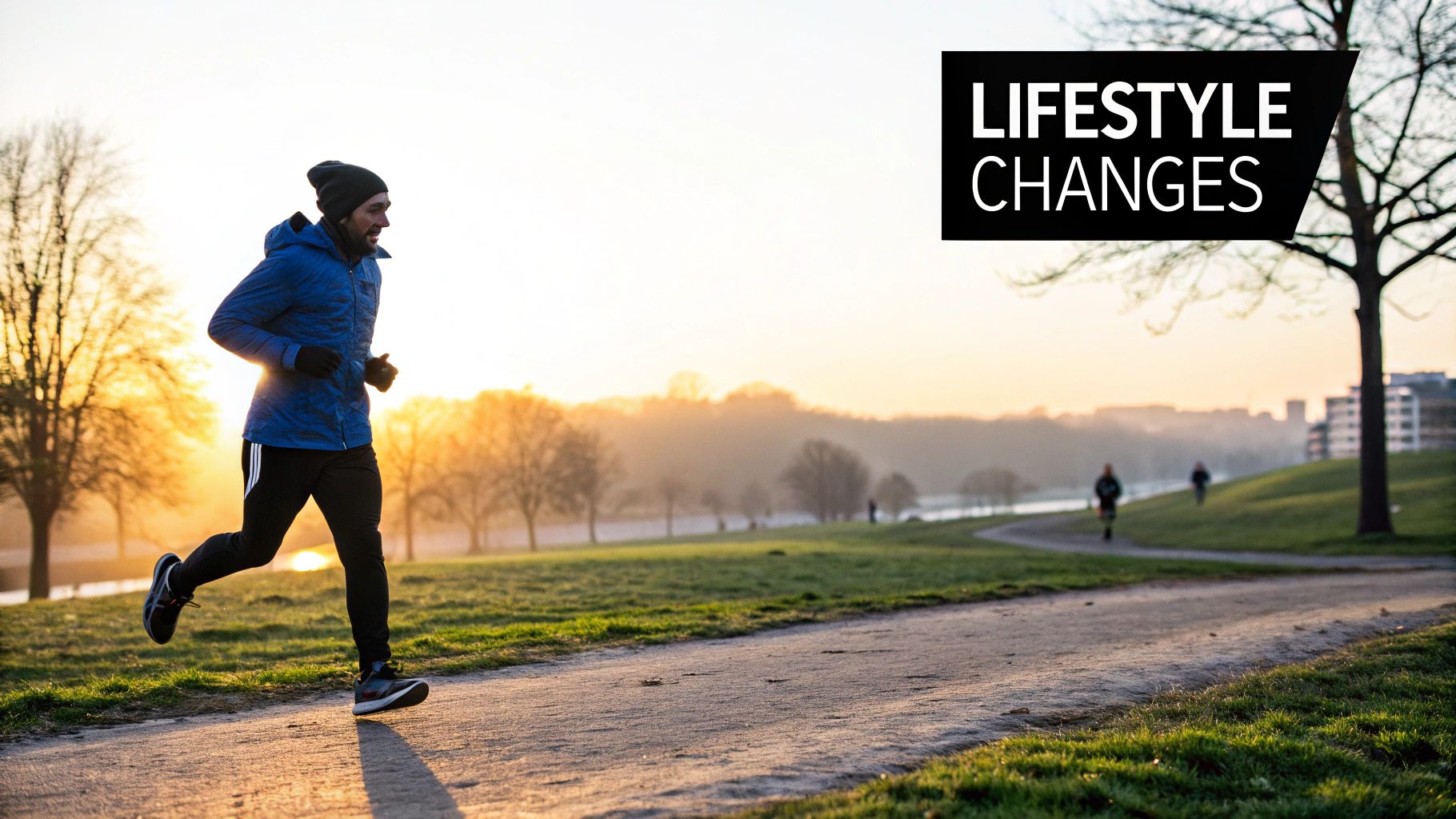
Why Neutralyze is the Logical First Step
When you lay out all the alternatives to Accutane, a high-quality topical system really stands out as the most logical and balanced place to start. It sidesteps the systemic risks that come with pills and the high costs of clinical procedures, all while delivering the kind of strength that most natural options just can't match. This is exactly the gap that Neutralyze was designed to fill.
Our system was engineered to be a complete solution, hitting acne from multiple angles at the same time. We don't just lean on a single active ingredient that makes you choose between seeing results and dealing with irritation.
We created Neutralyze to put an end to the frustrating trade-offs in acne care. By combining multiple proven ingredients into one synergistic system, it delivers powerful, visible results without sacrificing the health and comfort of your skin.
The Science Behind Clear Skin
The magic is in our unique, multi-action formula. We’ve brought together two of the most trusted ingredients in dermatology and given them a serious upgrade with some smart science.
- Salicylic Acid: This BHA is the absolute gold standard for getting deep into your pores. It dissolves the gunk—oil and dead skin cells—that causes clogs, clearing up the breakouts you have and stopping new ones from starting.
- Mandelic Acid: A gentler AHA that comes from almonds, this powerhouse exfoliates the surface of your skin to smooth its texture, calm inflammation, and help fade those stubborn post-acne marks. Because its molecules are larger, it works its magic without the harsh irritation you might get from other acids.
We then supercharge this combination with our advanced Nitrogen Boost Skincare Technology. Think of it as a specialized delivery system that helps the active ingredients work much more effectively, leading to clearer skin and better texture, faster.
When you choose Neutralyze, you’re not just picking up another acne product. You’re committing to a complete, scientifically-backed regimen built for both clearing your skin now and keeping it that way for the long haul. It's the smart, effective first step toward getting the clear, healthy skin you deserve.
Got Questions About Accutane Alternatives? We’ve Got Answers.
When you're looking for an alternative to a heavy-hitter like Accutane, it's natural to have a few questions. Let's clear up some of the most common ones so you can move forward with confidence.
Can Topical Treatments Really Handle Severe or Cystic Acne?
Absolutely. While it’s true that severe, cystic acne is tough to beat, the right kind of topical system is more than up to the challenge. It all comes down to finding a formula that fights acne from several different angles at once.
For instance, a system like Neutralyze doesn't just rely on one ingredient. It brings together pore-clearing Salicylic Acid and the gentler, anti-inflammatory Mandelic Acid. This combo can make a real dent in those deep, painful blemishes without the full-body risks that come with oral drugs. The key is sticking with it to keep inflammation and bacteria in check.
How Long Until I Should Expect to See Results?
Patience is a virtue, but you shouldn't be waiting around forever. With a well-formulated topical treatment, you should start noticing early signs of improvement—like less redness and fewer new pimples—within the first 2-4 weeks.
The bigger changes, like significant clearing, usually show up around the 8 to 12-week mark. This is when your skin has had time to adjust and your cell turnover cycle gets back on track. If three months go by with zero progress, it's probably a good idea to check in with your dermatologist.
Is It Safe to Mix and Match Different Acne Treatments?
You have to be careful here. Combining different treatments, especially powerful ones, should really be done with a dermatologist's supervision. If you mix something like a retinoid with a high-strength benzoyl peroxide wash, you could end up with a seriously irritated and damaged skin barrier.
This is where a complete system really shines. A thoughtfully designed regimen like Neutralyze takes the guesswork out of it by balancing effective ingredients for you. It provides a powerful, multi-pronged attack on acne, making it one of the most dependable alternatives to Accutane for getting clear and staying that way.
Ready to find a balanced, effective path to clear skin? See how the science-backed, multi-action system from Neutralyze can deliver lasting results without the harsh trade-offs. Explore our products today!
